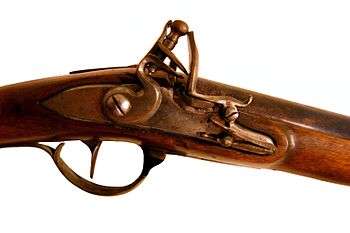Lock (firearm)
The lock of a firearm is the firing mechanism used to ignite the propellant. Lock, stock and barrel is an old figure of speech defining the totality of a firearm as the barrel through which the bullet is directed toward a target, the stock which provides a means of gripping the firearm, and the lock as all other essential parts. As might be deduced from its placement as the first mentioned, the lock is a complex part essential to the functioning of the firearm.

History
The earliest firearms were cannon mounted on carriages and ignited by a glowing ember or slow match. As the mobility advantages of smaller hand-held cannon were explored, the difficulty became obvious for a single individual to simultaneously move the slow match from a safe storage location to the ignition vent while keeping the cannon pointed at the target. The matchlock was devised to quickly move the slow match to the ignition vent when the trigger was actuated while holding the slow match safely away from the ignition vent at other times. The earliest locks may have been a simple lever centrally pinned to the firearm with the slow match at one end while the opposite end was held for movement. A major improvement was spring loading that lever toward the ignition vent with a catch to hold the lever away from the vent until the catch was released by a trigger.[1] The essential elements of a trigger and moving parts near the rear of the barrel evolved through the wheellock, snaplock, snaphance, miquelet lock, doglock, flintlock, and caplock. The term firelock was originally applied, as the name suggests, to the matchlock, but was later successively applied to the wheellock and then the flintlock as each was invented.[2][3]
Breech-loading firearms
As muzzleloaders were replaced by metallic cartridge firearms the lock functions have been included as part of the receiver and ammunition handling mechanism known as the firearm action.[4] A few modern firearms include electronic firing mechanisms.
See also
References
- Ramage, C. Kenneth (1980). Cast Bullet Handbook (3rd ed.). Middlefield, Connecticut: Lyman Publications. p. 8.
- Pennsylvania Archaeologist. 36–40. Society for Pennsylvania Archaeology. 1966. p. 13.
- Penny cyclopaedia of the Society for the Diffusion of Useful Knowledge, Penny cyclopaedia of the Society for the Diffusion of Useful Knowledge, Vol.1, p. 375, C. Knight, 1833.
- Craige, John Houston (1950). The Practical Book of American Guns. New York: Bramhall House. pp. 102&103.